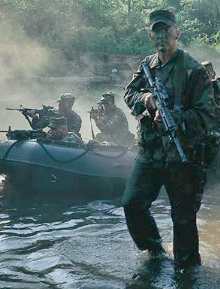| US Army Special Forces had
it's genesis during WWII when the Office of Strategic Services (OSS)
was created.
The OSS mission definition was intelligence gathering, support of
resistance movements, and sabotage. Toward these ends, the OSS created
"Jedburgh" teams (named after the Scottish town where they
trained) consisting of three men: a leader, an executive officer, and a
radio operator. Normally the radio operator was American, one officer
was Free French, and the other American. They parachuted into
Nazi-occupied France to conduct sabotage and guerilla warfare, and to
lead French guerrilla forces (called the maquis) against the Germans.
They provided advice, expertise, and leadership, and arranged airdrops
of arms and ammunition. |

Green Berets in action |
In 1952, the Army Special Forces were formed by recruiting former OSS
officers (with Jedburgh experience) and veterans from the elite Rangers
and Airborne Army units. Captain Aaron Bank was recruited from the OSS
and became the first leader of the Special Forces. Headquartered at Ft.
Bragg, North Carolina, the unit's mission was "to infiltrate by
land, sea, or air deep into enemy-occupied territory and organize the
resistance/guerrilla potential."
Candidates were required to speak more than one language. They were
trained in at least two of the basic Special Forces skills:
intelligence, communications, demolitions, weaponry, and medical aid, as
well as how to operate behind enemy lines with little or no outside
support. Special Forces units were organized into "A" teams
consisting of two officers and ten enlisted men.
Special Forces units had worn a green beret since it was designed by
Major Herb Brucker in 1953. He got the idea from the berets worn by the
elite troops in European armies, but his green beret was not officially
authorized Army headgear. President John F. Kennedy became a big
supporter of Special Forces because he appreciated the value of elite
troops and he considered the green berets that were worn by many Special
Forces soldiers to be "symbolic of one of the highest levels of
courage and achievement of the United States military." Kennedy's
support was instrumental in convincing the Army to make the green beret
the official headgear of all Special Forces units in 1961. Thereafter,
all Special Forces units were known as Green Berets.
During the 1950s the Green Berets carried out many "Cold War"
missions to resist the spread of communism around the world. They
supported rebels fighting against communist governments in unfriendly
countries and helped friendly countries battle communist insurgencies,
but they were not well known outside of the military establishment
because nearly all of their missions were secret.
Vietnam
After WWII, the French reoccupied South Vietnam in an ill-fated
attempt to resurrect their prewar empire. The North Vietnamese wanted to
reunify their country, so they fought a guerrilla war to convince the
French to leave. In 1956, Green Berets were sent to Vietnam to assist
the French and train South Vietnamese soldiers in modern warfare and
counter-insurgency techniques.
The "A" teams trained and fought alongside the natives from
outposts in remote areas. During the war, the Green Berets won 17 Medals
of Honor, 814 Silver Stars, and over 13,000 Bronze Stars. The Green
Berets also provided medical care and built schools and hospitals as
part of the program to win the "hearts and minds" of the local
populace.
The Green Berets began to gain notice and popularity with the American
public after the publication in 1962 of The Green Berets by Robin Moore.
A Green Beret Staff Sergeant and medic named Berry Sadler, wrote and
recorded a very popular song called The Ballad of the Green Berets in
1966. And in 1968, John Wayne produced, directed, and starred in a movie
called The Green Berets.
On November 20, 1970, a rescue mission called the Son Tay Raid was
launched to rescue 75 American POWs from a North Vietnamese prison camp
about 23 miles from Hanoi. The mission was executed brilliantly and no
Green Berets were lost. Unfortunately, no prisoners were rescued either.
The POWs had been moved a couple of days earlier. The raid did help the
POW's morale though, because the North Vietnamese decided to move all
the POW's to a central facility in Hanoi where they were no longer
kept in isolation from their comrades.
Special Forces Take the Lead
After the US withdrew from Vietnam, budget cuts in the late 1970s
forced the Army to rethink its dependence on large conventional forces
and to consider the use of more elite units. It was thought that in the
future, wars could be fought with air power and small units of highly
trained men.
The Army put this plan into effect during Operation "Just
Cause," the invasion of Panama to remove its despotic leader Manuel
Noriega and stop him from allowing Panama to be used as a way-station by
drug runners. The invasion and capture of Noriega was carried out
entirely by Green Berets, Rangers, and Navy Seals.
During Desert Shield, the first war against Iraq that secured the
liberation of Kuwait, Special Forces went into Kuwait early to train
resistance forces. Once the air war was launched, Green Berets operated
well behind enemy lines providing intelligence and targeting data to
direct air units on concealed and elusive targets like the Iraqi mobile
scud missiles.
Prior to the commencement of the ground war, Special Forces were
instrumental in clearing lanes through the minefields and trenches that
blocked the invasion routes for the conventional forces. After Kuwait
was liberated, Special Forces helped to reconstitute the Kuwaiti armed
forces.
The War on Terror
After the terrorist attacks on the World Trade Center and the
Pentagon on September 11, 2001, the U.S. declared war on international
terrorism. President George W. Bush announced the "Bush
Doctrine" during his State of the Union Address on Sept. 20, 2001,
when he said "We will pursue nations that provide aid or safe haven
to terrorism. "
Afghanistan had long been a safe haven for the terrorist organization
known as Al Quaeda and its leader, Osama Bin Laden, who were responsible
for the terrorist attacks on 9/11/01. The U.S. demanded that Afghanistan
turn over Bin Laden and his associates and then invaded Afghanistan when
its demand was ignored. The ground war was fought almost entirely by
Special Forces and Rangers leading, or in cooperation with indigenous
forces provided by the "Northern Alliance." The war was over
quickly, but Bin Laden has yet to be captured. He is believed to be
hiding in the border region between Afghanistan and Pakistan where the
rugged terrain makes military operations very difficult to sustain, and
Special Forces continue to hunt for Bin Laden in that area.
Special Forces spearheaded the invasion of Iraq on March 20, 2003, to
remove the dictator Saddam Hussein and to free the Iraqi people from the
excesses of his Ba'athist regime. The war lasted approximately three
weeks, but securing the peace has been far more difficult and continues
to this day. Special Forces are now training the new Iraqi army and
police forces, as well as providing humanitarian aid to the people of
Iraq.
The Green Beret's motto is "De Oppresso Libe" (To Free the
Oppressed) and today Special Forces troops are stationed in trouble
spots all over the world, fighting terrorism and training local forces
in counter-terrorism tactics, techniques, and procedures so that someday
the entire world will be liberated from the scourge of terrorism.
For more guerrilla warfare, see Guerrilla
Warfare Part 5: Delta Force
|




